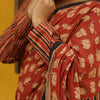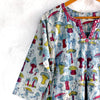Traditional Weaving Techniques in Chanderi Sarees Explored
- by Divyesh Patel
Delving into the realm of Chanderi sarees unveils a world where tradition meets innovation. The blend of silk and cotton weaves intricately crafted patterns reflecting nature, mythology, and daily life. Zari threads add a touch of opulence, symbolizing tradition and richness. Advanced technology like Jacquard looms preserves ancient techniques while enhancing efficiency. Traditional motifs like floral designs and zari work showcase the weavers’ expertise and cultural heritage. Every thread woven tells a story of artistry, dedication, and deep-rooted craftsmanship. Explore further to unravel the timeless allure of Chanderi weaving techniques.
Historical Origins of Chanderi Weaving
We trace the historical origins of Chanderi weaving back to ancient times when skilled artisans in the heart of India meticulously crafted exquisite textiles using traditional techniques. The evolutionary development of Chanderi weaving is a testament to the rich cultural influences that have shaped this art form over centuries. Artistic inspirations drawn from nature, mythology, and daily life have been intricately woven into the fabric of Chanderi sarees, reflecting a deep connection to the heritage and traditions of the region.

Design variations in Chanderi weaving have evolved over time, blending traditional motifs with contemporary styles to cater to changing tastes and preferences. The delicate patterns, intricate borders, and vibrant colors used in Chanderi sarees showcase the craftsmanship and attention to detail that define this ancient art form. Each saree tells a story of the weaver’s skill and creativity, making it a cherished piece of clothing that embodies the essence of Indian textile heritage.
Silk and Cotton Blending Techniques
Weaving silk and cotton together is a meticulous process that requires a deep understanding of both fibers’ characteristics. The blending techniques in Chanderi sarees involve carefully combining silk and cotton threads to create a luxurious yet breathable fabric. This intricate process results in the unique texture and sheen that make Chanderi sarees highly sought after in the world of traditional textiles.
Silk-Cotton Weaving Process
Utilizing a blend of silk and cotton fibers, the weaving process in Chanderi sarees intricately combines the strengths of both materials to create a unique and luxurious textile. Silk weaving in Chanderi is a delicate art form that dates back centuries, known for its fine texture and natural sheen. Cotton weaving, on the other hand, adds durability and breathability to the fabric, making it suitable for various climates. The process begins with carefully selecting the finest silk and cotton threads, which are then dyed using traditional techniques to achieve vibrant colors.
The weavers meticulously interlace these threads on handloom, a painstaking process that requires precision and skill. By blending silk and cotton in specific ratios, the resulting fabric marries the softness of silk with the sturdiness of cotton, creating a luxurious textile that drapes elegantly and feels comfortable against the skin. This intricate weaving technique not only showcases the craftsmanship of the artisans but also highlights the rich cultural heritage of Chanderi sarees.
Blending Techniques Explained
How do skilled artisans in Chanderi expertly blend silk and cotton fibers to create the luxurious and durable textile of Chanderi sarees? The blending techniques in Chanderi involve a meticulous process of color blending and texture manipulation. To achieve the perfect blend, artisans carefully mix silk and cotton fibers in varying ratios to create a fabric that embodies the best qualities of both materials.

Color blending plays a crucial role in achieving the desired aesthetic appeal of Chanderi sarees. Artisans skillfully combine different colored silk and cotton threads to create unique hues and patterns that enhance the overall look of the fabric. This intricate process requires a keen eye for detail and a deep understanding of how colors interact with each other.
Texture manipulation is another key aspect of blending silk and cotton fibers. By strategically altering the weave structure and yarn composition, artisans can create fabrics with diverse textures ranging from smooth and glossy to soft and matte. This manipulation not only enhances the tactile experience of the sarees but also adds depth and dimension to the overall design.
Role of Zari in Chanderi Sarees
The intricate use of zari, a metallic thread typically made of fine silver or gold, plays a significant role in enhancing the luxurious appeal of Chanderi sarees. Zari weaving techniques, passed down through generations, involve skilled artisans meticulously weaving the metallic thread into the fabric, creating stunning patterns that catch the light and add a touch of opulence to the sarees. The cultural significance of zari in Chanderi sarees goes beyond mere embellishment; it symbolizes tradition, wealth, and elegance, making each saree a piece of art.
Zari embellishments in Chanderi sarees showcase the mastery of traditional craftsmanship, with artisans expertly incorporating zari into the fabric to create intricate designs that reflect the rich cultural heritage of the region. The shimmering zari threads add a touch of glamour to the sarees, making them perfect for special occasions and celebrations. The careful placement of zari highlights the beauty of Chanderi sarees, making them a coveted choice for those who appreciate fine craftsmanship and timeless elegance.
Jacquard Looms in Weaving Process
In the intricate weaving process of Chanderi sarees, the utilization of Jacquard looms plays a pivotal role in achieving the intricate patterns and designs characteristic of this traditional craft. The integration of Jacquard looms represents a significant advancement in the textile industry evolution, allowing for more intricate and complex designs to be woven with precision and speed. These looms have not only revolutionized the production process but have also preserved the cultural significance and artistic craftsmanship associated with Chanderi sarees. Here are four key points to consider:
- Enhanced Design Versatility: Jacquard looms enable weavers to create intricate patterns and motifs that were once only possible through hand-weaving techniques.
- Increased Efficiency: The use of Jacquard looms has significantly improved productivity by automating the process of pattern creation, reducing the time and effort required for weaving.
- Preservation of Traditional Techniques: Despite technological advancements, Jacquard looms have been instrumental in maintaining the authenticity and cultural heritage of Chanderi sarees.
- Quality Assurance: These looms ensure consistency in design and quality, reflecting the meticulous attention to detail and artistic finesse that define Chanderi sarees.
Traditional Motifs and Designs
Utilizing centuries-old traditional motifs and designs, Chanderi sarees showcase a rich tapestry of cultural heritage and artistic craftsmanship. The traditional motifs found in Chanderi sarees are deeply rooted in Indian culture and history, each design telling a story of its own. From delicate floral patterns symbolizing beauty and grace to intricate geometric shapes representing balance and harmony, every motif is carefully chosen to evoke a sense of tradition and elegance.

The intricate designs in Chanderi sarees are a testament to the skill and expertise of the weavers. These designs are often created using techniques like zari work, where threads of gold and silver are woven into the fabric, adding a touch of luxury and sophistication. Other common design elements include butis (small motifs scattered across the saree), paisleys, and traditional borders known as kinari.
Incorporating these traditional motifs and designs not only adds to the aesthetic appeal of Chanderi sarees but also preserves the cultural heritage and craftsmanship passed down through generations. The meticulous attention to detail and the artistry involved in creating these designs make Chanderi sarees truly special and timeless pieces of art.
Dyeing and Color Mixing Methods
Crafting Chanderi sarees involves employing an array of dyeing and color mixing methods to achieve the vibrant and intricate hues that define this traditional textile art. Natural dyeing methods play a significant role in the creation of Chanderi sarees, with artisans utilizing plant-based dyes like indigo, turmeric, and madder root to infuse the fabric with rich, earthy tones. Sustainable dye techniques are also prevalent in Chanderi weaving, ensuring minimal environmental impact while maintaining the authenticity of the craft. Traditional color mixing is meticulously executed, with weavers blending different hues to achieve the perfect shade for each design. Ancient color blending techniques, passed down through generations, are still utilized to create harmonious combinations that reflect the cultural heritage of Chanderi sarees. The delicate balance of colors in Chanderi sarees is a testament to the mastery of dyeing and color mixing methods that have been refined over centuries.
Mastering the Handloom Craft
As we explore the intricate world of Chanderi sarees, we are drawn to the mastery of handloom craft that is deeply ingrained in the fabric of this tradition. The skillful weaving techniques employed by artisans not only showcase their expertise but also highlight the rich heritage of this art form. Through the delicate interplay of yarns and threads, the handloom craft techniques used in Chanderi sarees exemplify a timeless elegance that continues to captivate admirers worldwide.
Skillful Weaving Traditions
Weaving traditions in Chanderi sarees exemplify the intricate mastery of handloom craftsmanship, showcasing the skillful artistry passed down through generations. The delicate threads intricately woven by skilled artisans not only reflect their expertise but also hold deep cultural significance. Here are four insights into the skillful weaving traditions of Chanderi sarees:
- Heritage Weaving Techniques: The weaving techniques used in Chanderi sarees are a blend of traditional methods and modern innovation, creating a unique textile that stands out for its finesse.
- Symbolism in Patterns: Artisan craftsmanship is evident in the intricate patterns and motifs woven into Chanderi sarees, with each design inspired by nature, mythology, or historical events, adding layers of meaning to the fabric.
- Precision and Patience: The art of Chanderi weaving requires meticulous attention to detail and a patient approach, as even the smallest error can impact the final product’s quality.
- Design Evolution: While rooted in tradition, Chanderi sarees also adapt to contemporary tastes, showcasing how artisan expertise continues to evolve while maintaining the essence of the craft.
Artisan Expertise Highlighted
With meticulous precision and a deep understanding of textile traditions, Chanderi artisans showcase their unparalleled expertise in mastering the intricate handloom craft of saree weaving. The artisan techniques passed down through generations are not just skills; they are a reflection of the rich cultural heritage ingrained in every thread they meticulously weave. Their handloom expertise goes beyond mere technical proficiency; it embodies a deep respect for the artistry and history woven into each Chanderi saree.

These artisans possess weaving skills that are honed over years of dedication and practice, resulting in the creation of exquisite fabrics that stand as testaments to their commitment to perfection. Every motif, every weave, and every design element is carefully crafted by skilled hands that understand the nuances of the craft like no other. It is this attention to detail and unwavering passion for their work that elevates Chanderi sarees to a level of artistry that transcends mere clothing, becoming cultural treasures that embody the essence of tradition and craftsmanship.
Handloom Craft Techniques
Mastering the intricate handloom craft of saree weaving requires a deep understanding of textile traditions and meticulous precision from Chanderi artisans. We, as artisans, constantly hone our skills to create exquisite Chanderi sarees that showcase our heritage and expertise. Here are some key aspects of mastering the handloom craft:
- Loom Technology: Understanding the different types of handlooms used in Chanderi weaving is fundamental. From traditional pit looms to more modern jacquard looms, each plays a crucial role in the weaving process.
- Weaving Patterns: Mastery of weaving patterns is essential for creating the intricate designs that adorn Chanderi sarees. This includes knowledge of traditional motifs, such as the Ashrafi Buti or the Nalferma pattern.
- Attention to Detail: The devil is in the details when it comes to handloom weaving. We pay meticulous attention to every thread, ensuring consistency and quality in the final product.
- Innovative Techniques: While traditional techniques form the backbone of Chanderi weaving, artisans also explore innovative methods to push the boundaries of design and craftsmanship.
Intricate Jamdani Weaving Style
Utilizing intricate patterns and meticulous attention to detail, the Jamdani weaving style in Chanderi sarees showcases a blend of tradition and artistry that captivates the eye. Historically, Jamdani weaving has roots in Bangladesh and West Bengal, where skilled artisans would weave muslin fabrics with delicate motifs by hand. This technique eventually made its way to Chanderi, where it was seamlessly integrated into the traditional weaving practices, adding a new layer of complexity and beauty to the sarees.
The intricate weaving patterns in Jamdani sarees hold deep cultural significance, often featuring motifs inspired by nature, mythology, and geometric designs. These patterns not only enhance the visual appeal of the sarees but also carry stories and traditions passed down through generations. In contemporary times, Jamdani weaving continues to evolve, with weavers incorporating modern elements and experimenting with different color palettes to cater to changing preferences while preserving the essence of this timeless craft.
Innovations in Modern Weaving
We constantly witness a dynamic shift in modern weaving techniques, where traditional methods intertwine with contemporary innovation to redefine the artistry of textile production. As we delve into the realm of innovations in modern weaving, it is fascinating to observe the evolution of sustainable practices and the integration of cutting-edge textile technology into the traditional craft of Chanderi sarees. Here are some key aspects shaping the landscape of modern weaving in Chanderi:
- Sustainable Innovations: The adoption of eco-friendly materials and processes, such as organic dyes and recycled fibers, reflects a growing commitment to sustainability within the weaving community.
- Artisan Collaboration: Collaborations between traditional weavers and modern designers bring fresh perspectives and innovative techniques to Chanderi saree production, ensuring the preservation of heritage while embracing contemporary trends.
- Textile Technology Integration: Advancements in machinery and digital tools have revolutionized the weaving process, enhancing efficiency and precision without compromising the authentic charm of handloom textiles.
- Contemporary Designs: The fusion of traditional motifs with modern aesthetics results in captivating designs that appeal to a diverse range of consumers, keeping Chanderi sarees relevant in today’s fashion landscape.
Significance of Chanderi Weaving Tradition
Exploring the enduring legacy of Chanderi weaving tradition reveals a rich tapestry of cultural significance woven into every thread of the exquisite sarees. The Chanderi weaving tradition is deeply rooted in India’s cultural heritage, dating back to the 13th century when the art form flourished under the patronage of the Bundela Rajputs. The intricate weaving techniques passed down through generations encapsulate the essence of artistic expression and craftsmanship.

Each Chanderi saree is a testament to the meticulous skills of the weavers who painstakingly create these masterpieces. The interplay of traditional motifs, delicate zari work, and sheer textures reflects a harmonious blend of past and present. The weaving techniques employed in crafting Chanderi sarees not only showcase the weavers’ expertise but also symbolize a connection to the rich tapestry of Indian culture.
The significance of the Chanderi weaving tradition extends beyond its aesthetic appeal; it serves as a reminder of the enduring legacy of craftsmanship and artistry that continues to thrive in the modern world. The cultural heritage preserved within each saree speaks volumes about the resilience and creativity of the artisans who keep this tradition alive.
Frequently Asked Questions
How Has the COVID-19 Pandemic Affected the Chanderi Weaving Industry?
The pandemic drastically impacted the Chanderi weaving community. We faced financial struggles due to decreased market demand. To adapt, we embraced online sales and sought financial support to sustain our craft and livelihood during these challenging times.
What Are the Challenges Faced by Weavers in Preserving Traditional Techniques?
Facing challenges in preserving traditional techniques, weavers grapple with skill development gaps and lack of government support. Despite these hurdles, our community strives to innovate while honoring our heritage, weaving resilience into each thread.
Are There Any Sustainable Practices Implemented in Chanderi Saree Production?
We prioritize sustainability in Chanderi saree production. Eco-friendly practices like using natural dyes and supporting ethical sourcing are fundamental to our process. By valuing these principles, we ensure a positive impact on both artisans and the environment.
How Do Weavers Ensure the Authenticity and Quality of Chanderi Sarees?
In our weaving community, quality control is like crafting a masterpiece. We ensure authenticity by meticulously inspecting every thread and pattern, passing down generations of knowledge. It’s our heritage, our pride.
What Is the Impact of Changing Fashion Trends on Traditional Chanderi Weaving?
As fashion evolves, the impact on traditional Chanderi weaving is significant. The changing trends affect the market demand for these exquisite sarees, influencing artisan livelihoods and preserving the cultural heritage embedded in each thread.
Conclusion
As we delved into the rich history and intricate techniques of Chanderi weaving, we were awestruck by the artistry and skill involved in creating these timeless sarees. The threads of tradition are interwoven with innovation, creating a fabric that truly stands the test of time. Like a tapestry of culture and craftsmanship, Chanderi sarees are not just garments, but living pieces of history that deserve to be cherished and celebrated.






